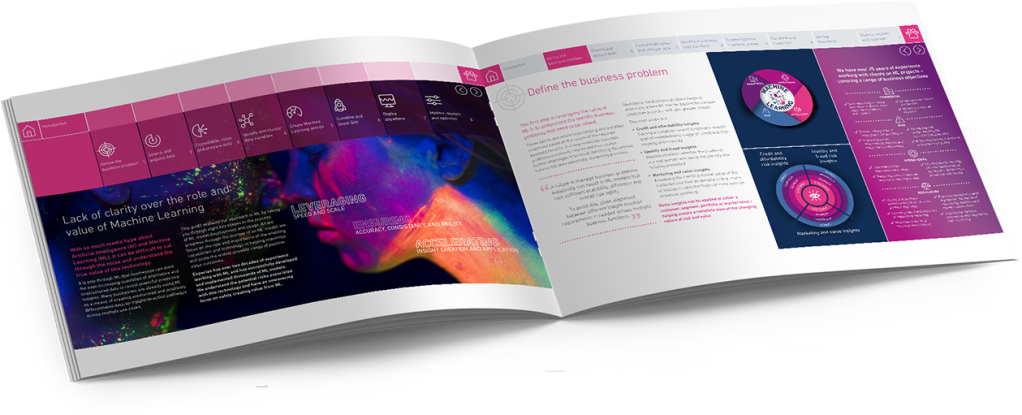With so much recent media hype about Artificial Intelligence (AI) and Machine Learning (ML), it can be difficult to cut through all the sensationalist speculations and understand the true value of this technology. Although the recent introduction of accessible Large Language Models is causing concern, the benefits of ML are well-established and overwhelmingly positive across many use cases.
ML is an essential tool to help businesses take advantage of the vast quantity of available data that grows exponentially each day. It allows them the flexibility to integrate new data sources quickly and understand the implications of this data in real-time. This in turn enables greater insight, agility and resilience in responding to rapidly changing macroeconomic conditions, market and customer risk, and fraud threats.
Our research shows that most businesses (62%) believe that AI and ML are already radically changing the way they do business. This indicates that ML is becoming a differentiating technology and this trend is likely to increase over the near future – helping businesses that use ML to gain a competitive advantage.
It is only through ML that businesses can distil the ever-increasing quantities of alternative and unstructured data to reveal powerful prescriptive insights. Many businesses are already using ML to create accelerated and positively differentiated data-to-insight-to-action pathways across multiple use cases.
This guide explains our approach to ML by taking you through eight key stages in the process of ML model development and usage. As we progress through the journey of an ML model, we focus on the enabling capabilities of ML in helping maximise and scale positive value outcomes.
Experian has over two decades of experience working with ML and has successfully developed and implemented thousands of ML models. We understand the potential risks associated with this technology and have an unwavering focus on safely creating value from ML.
Download your copy of the "Journey of an ML Model" now
DownloadFrom raw data to results optimisation: the eight stages of ML model development
Here is a brief overview of the different stages involved with creating an ML model that we explore in more detail in our guide. For each stage, we discuss some common pain points and how these can be overcome.

1. Define the business problem
The starting point is defining the business problem that needs to be solved. Once defined, this provides the context for the subsequent stages.
2. Search and acquire data
The data universe available to businesses is vast and constantly expanding. Having ready access to the most relevant and reliable data to solve the specific problem is critical.
3. Consolidate, clean and prepare data
Once you have identified the relevant data, it needs to be consolidated in a data repository and then cleaned to ensure a consistent format. Removing inaccurate data is essential to ensure the validity of the final model.
4. Identify and cluster data variables
The data then needs to be analysed and clustered into different data variables. This involves identifying the most relevant individual data variables or clusters of data variables that are likely to have the greatest impact on achieving the desired outcome.
5. Create ML scores
You must then choose which algorithm best suits your needs and data. There are a wide variety of algorithms, each suited to different datasets and analytical outcomes, and each provides a different output. Algorithm selection is a mix of science and expertise – each one delivers a score, which allows you to measure the performance of the model.
6. Combine and boost Gini
To improve the overall score multiple models, developed using different data sources, can be combined to boost the predictive accuracy. Accuracy can also be improved by fine-tuning the parameters – or variables – in each model.
7. Deploy anywhere
Before an ML model can be deployed in a live environment it needs to be rigorously tested with real data, evaluated against the business problem it addresses, and signed off by the appropriate risk and governance controls. Once it has reached this stage it is ready to be moved into production.
8. Monitor, explain and optimise
ML models require continual governance, validation, and improvement to ensure ongoing accuracy and stability. Another key aspect is ensuring that models are explainable to customers, internal auditors and regulators. Model outcomes can also be stored, recycled and optimised to inform further enhancements, creating a virtuous circle of continuous improvement and maximising overall ROI.
Download your copy of the "Journey of an ML Model" now
DownloadHow Experian can help with ML model development
Over the last 25 years, we have developed many ML-based products and have an in-depth understanding of the benefits – as well as the potential shortfalls – involved with ML models. With our unmatched blend of data, analytics, technology and expertise we are uniquely positioned to help you enhance your ML program.
We have access to the widest range of traditional and alternative datasets, with cutting-edge analytics skills and cloud-based technology to support your ML model development journey. Our team of expert consultants and specialists can help you progress through each stage of creating and implementing a customised ML model for your business.
Experian is a market leader in providing fully explainable and transparent ML models that provide you, your customers, and regulators with a clear indication of exactly which features led to each decision. Contact us today to find out how we can help you create powerful ML models that enhance your credit management, fraud risk and marketing strategies.
